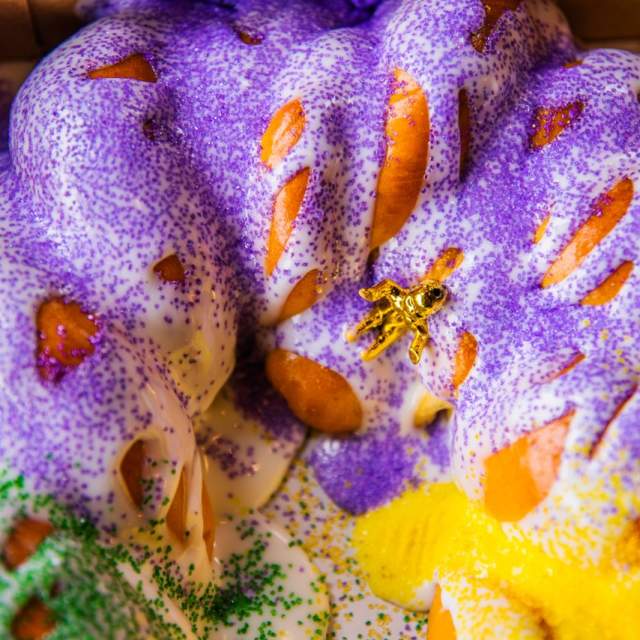Your browser is not supported for this experience.
We recommend using Chrome, Firefox, Edge, or Safari.
The Tradition of King Cake
The origin of the modern King Cake dates back to 12th century France, where the cake was baked on the eve of Epiphany, the final day of the Christmas celebration. It came to be known as "Twelfth Night," which commemorates the three kings' visit to the Christ child, 12 days after his birth. French settlers brought the custom of the King Cake to Louisiana in the 18th century. The Twelfth Night grand balls and events launch the carnival season and always include the presentation of the Twelfth Night Cake or King's Cake.
There are many traditions regarding the King Cake. All agree that the cake must be round in the shape of a crown and bejeweled to look like a crown with carnival-colored sugars, purple, green and gold. The official Mardi Gras colors were chosen in 1872 by the King of Carnival, Rex and each has a meaning: gold- power, green- faith, and purple- justice. They were baked with golden beans inside for the ladies of the court. The lady whose slice contained the bean was crowned queen of the festivities, and this began the Mardi Gras King Cake tradition.
Eventually, plastic babies were used in the King Cake as it became an integral part of the tradition of Mardi Gras. Today, family, friends, businesses, and classrooms have their own King Cake parties. Whoever gets the piece of cake with the plastic baby hosts the next King Cake party, or buys/bakes the next cake.
The cake, a gift shared by family, friends, and revelers alike, is eaten between Twelfth Night and Fat Tuesday, the beginning of Lent. However, the cake often begins appearing during Christmas.
Most king cakes are decorated with many vibrant party items. They include Mardi Gras cups, masks, assorted Mardi Gras beads, doubloons (pirate coins), and of course the baby. The average king cake contains many delicious ingredients such as pecans, brown sugar, powdered sugar, fruit, chocolate, and an assortment of creams from strawberry to chocolate to Bavarian which go inside the king cake.
The Ultimate Southwest Louisiana King Cake Guide
Traditional, cream cheese, pecan praline, boudin, Galettes Des Rois... I will not discriminate! Below is a list of all bakeries, coffee shops, donut shops, and…
 King Cake Recipes
King Cake Recipes

#EatSWLA: Mardi Gras Boudin King Cake Recipe
The boudin king cake craze hit the Mardi Gras scene in 2014. It is the savory “sibling” to the season’s sweet treat of cream cheese and…
How to Make a Bayou® Rum Mardi Gras Daiquiri
Get into the Mardi Gras spirit with this simple Mardi Gras Daiquiri recipe from Bayou® Rum! You don't want to skip out on making the King Cake simple…






